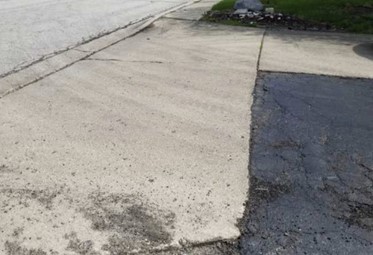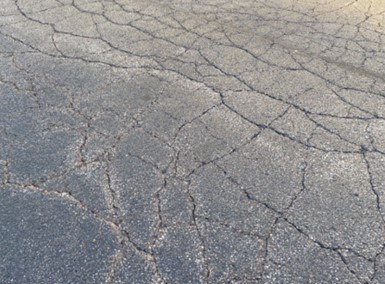There are various types of parking areas at commercial properties, ranging from multi-story parking structures to gravel parking pads. Multi-story parking garages can be complex and contain systems beyond most inspectors’ comfort level. In this case, the inspector can exclude the parking structure altogether through the pre-inspection agreement or by bringing a specialty consultant to handle that portion of the inspection. Here, we will focus on standard ground-level parking areas.
Concrete Parking Areas
Concrete is exothermic, which means that it creates heat during the curing/hardening process. During this process, concrete is prone to cracking, so sawn or tooled control joints (also referred to as contraction joints) are added to slabs to minimize random cracking, or, in other words, to “control” the cracking to pre-determined locations. Without these joints, the concrete could crack without any design guidance, thus compromising its integrity. Another approach to control cracking is utilizing steel reinforcement in the slab.
Note that it may take concrete up to 28 days to reach the engineered or desired hardness.
Additionally, concrete professionals “strike off” concrete forms to the desired thickness during installation, and finishing tools are used to finish the surface. As this finishing process occurs, the cement, sand, and water create a slurry or mud at the topmost surface. Some concrete finishers call this the “cream layer.” It’s visible as the smooth layer when the concrete becomes hard.

Concrete driveway
If the topmost surface is worn away or damaged, the aggregate below might be exposed and appear as a rough texture. This is referred to as spalling. A common cause of spalling occurs when the cream layer is allowed to freeze during the curing process. The inspector may also notice spalling and cracking in concrete parking areas from abrasion, impact, and environmental factors, such as snow plows, heavy trucks, and salt application for ice control in cold climates.
Cracking, spalling, and other damage found in concrete parking areas can be costly to repair. However, the advantage of concrete is its long service life. A concrete parking area could last as long as 50 years. Preventative maintenance for concrete includes joint sealing and annual cleaning to prolong its life expectancy. For additional information about inspecting concrete, read InterNACHI’s article Visual Inspection of Concrete online.
Asphalt Parking Lots

Alligatoring in asphalt parking area
Asphalt is a popular and cost-effective method of paving parking areas. Asphalt is comprised of both large and small aggregate and a bitumen binding material. Bitumen is a petroleum-based product, so the cost can fluctuate with the price of oil. During installation, the mixture is heated as high as 350º F. Then, it’s placed using machines and compacted with a vibrating roller machine to the desired density and thickness. Once compacted and cooled, vehicles and people can travel on the asphalt in a few hours or a day, depending on the weather conditions.
Unlike concrete parking areas, asphalt doesn’t require control joints, allowing for a large smooth surface. However, asphalt parking areas are more susceptible to damage from sun exposure. The UV rays can weaken the pavement and cause alligatoring, which is cracking and deterioration of the top layer. In addition, freeze-thaw weather cycles worsen cracking and can lead to potholes.
Heavy vehicle traffic can also soften the surface of an asphalt parking area, which can lead to cracks. The cracks can worsen to potholes and other surface damage. The inspector should check certain areas for greater wear and tear at locations where vehicles turn, such as at corners of entry and exit, and at loading docks.
Due to its composition, asphalt also has a “memory.” If the vehicle traffic is consistent or travels in the same line, this can cause the asphalt to rut or break down. Hence, heavy traffic damage might occur around loading docks and truck pads. It is common for inspectors to see concrete used in the truck traffic areas, and asphalt in the other areas for cost efficiency. For instance, consider an asphalt parking area with concrete around the loading dock. In this case, the area around the loading dock is typically referred to as a concrete apron.
Note that asphalt is typically about half of the initial cost of concrete, but has a life expectancy of about 20 to 30 years. Preventative maintenance for asphalt includes regular cleaning and sealant application every three to five years. This will help prolong its life expectancy and counteract damage from sun exposure. All in all, the maintenance cost over the lifespan of the asphalt is relatively low compared to the premature replacement of concrete paving. Maintenance also helps repair cracks right away instead of allowing the condition to worsen, especially under conditions of excessive water penetration.
Brick Parking Areas
Brick is also a method for finishing parking areas or other exterior areas, such as walkways. However, it requires special engineering and design to help control drainage. When water-draining pavers or permeable pavers are installed, the ground under the pavers can be designed to be the drainage plan, instead of adding storm sewers or catch basins. These pavers may also be installed to help the building attain energy use awards or certifications.
The most common issue found with brick paver lots is heaving and undulation. If the base under the brick is not properly prepared, frost or other ground conditions can cause the pavers to rise and fall with the weather. This will leave the pavers uneven and create a potential trip hazard.
Brick parking areas can cost as much as three times that of concrete, so the savings or aesthetics must be worth the cost.
Gravel Parking Area
Gravel or crushed aggregate may be the most affordable type of parking area. The rock consists of crushed limestone, cinders, recycled concrete, and/or recycled asphalt. These are spread to an even layer and graded to provide drainage.
One of the disadvantages of gravel is the constant maintenance due to gravel displacement by vehicle traffic, erosion, water damage, or other factors. Therefore, the inspector’s client may find it helpful to know that gravel parking areas require grading on at least an annual basis. A gravel parking lot costs a fraction of what a hard parking lot would cost.
Protection Features: Bollards and Parking Logs

Parking bollard
A bollard is a short post that diverts vehicle traffic way from a building, exterior structural components, and pedestrian walkways. Bollards should be solid and bright-colored for visibility. These are important safety features used to prevent damage to building features, such as garbage corrals, landscaping, gas meters, etc., as well a way to direct vehicles to designated parking zones. The inspector should look for signs of rust on steel bollards, and other signs of physical damage if they’re made of concrete.

Parking log
A parking log is a block installed at the head of a parking space to separate individual spaces and to prevent vehicles from impacting a building, other vehicles, pedestrians, and/or landscaping. Parking logs may be made of recycled tires, post-consumer products, or concrete.
The inspector should check that the logs are securely anchored to the pavement to prevent movement under impact, as well as signs of physical damage.
Drainage
It is essential for drainage elements in parking areas to be thoughtfully designed, installed, and maintained to avoid flooding during heavy rains. Commercial property inspectors should check that catch basins, drainage basins, and other drain features are free of debris and adequately maintained. For additional information, read the article “Catch Basins.”
Conclusion
Most commercial parking areas are composed of concrete, asphalt, or a combination of both. Brick and other materials are less common. The inspector must report on the condition of the entire area, including cracking, spalling, potholes, and other signs of deterioration. The inspector should also take inventory of any safety features, such as paint, bollards, and parking logs. This information is important for building safety. For example, a trip or fall from a pothole could result in a lawsuit for your client.
Clients may find it useful if you include information and recommendations for preventative maintenance of parking areas in your inspection report.
Article Written By: Rob Claus®
Additional Resources for Commercial Property Inspectors:


